August 9 – 15 is OSHA’s Safe + Sound Week for 2021; a campaign developed to encourage organizations to create, update, and improve workplace safety programs. This year the theme is 10 Ways to Get Your Safety and Health Program Started.

If you want to get started but don’t know how, many resources are available from OSHA and Rexel. Here are a few:
Starting a safety program is the right thing to do, and it can also help prevent workplace injuries while helping you avoid hefty OSHA fines. Keep the following six tips in mind as you develop your program.
Familiarize yourself with the appropriate health and safety regulations for your industry. Then start the process of identifying hazards in your facilities and addressing them with policies, process changes, safeguards, communication, and training.
Safety must come from the top down. Before starting a safety program, think through the roles and responsibilities and assign concrete actions and tasks. Demonstrating strong safety leadership will validate your program’s importance.
Make safety a part of everyday life at your facility. Safety impacts all levels within an organization and every task performed. Building a safety culture means investing in safety, leading by example, providing necessary training, encouraging feedback, and promptly correcting issues.
When starting a safety program, it’s critical that you get your workforce involved and keep them engaged. If workers don’t have an active role in the program, they won’t participate in it. Encourage engagement with meetings, communications, and training and offer a reporting system.
A safety program is only as effective as the training that supports it. From onboarding to role-specific modules and courses, safety training and prevent accidents and save lives. Familiarize yourself with training regulations for your industry and develop a corresponding curriculum and schedule.

Safety isn’t something you can set and forget. As you begin the process of starting a safety program, don’t forget to include an assessment schedule. Conditions change and regulations get updated; evaluating your facility regularly can help you make improvements and ensure compliance.
As you get to work starting a safety program, remember—you’re not alone! We're here to help with expert advice. Contact us today!
